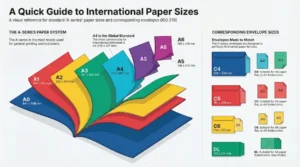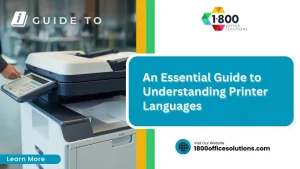Size Matters: Understanding Printer Paper Dimensions
Printer paper size options play a critical role in how documents appear and function. Whether you’re printing professional reports or flyers, understanding the various sizes available can make all the difference. Below is a quick guide to the essential options:
- Letter Size (8.5″ x 11″): Standard for most U.S. documents.
- Legal Size (8.5″ x 14″): Used primarily for legal documents.
- Tabloid Size (11″ x 17″): Ideal for spreadsheets and large visuals.
- A4 Size (210 x 297 mm): The most common size globally, especially outside North America.
Standardization is vital. In North America, the Letter size dominates, while the A4 size is king internationally. Choosing the correct paper size ensures your documents meet the expectations of their intended audience and print accurately every time.
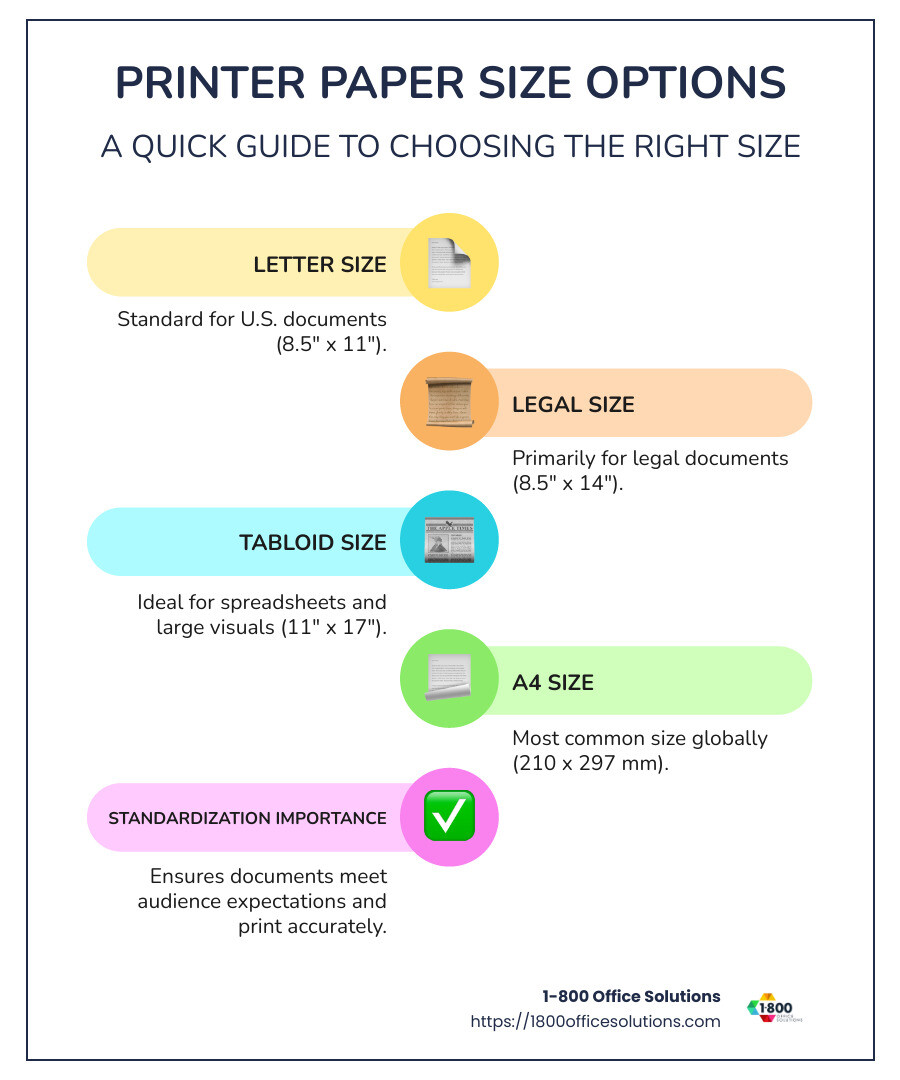
Understanding Paper Size Standards
When it comes to printer paper size options, the world is divided into two main systems: the ISO 216 standard and the North American system. Each has its own logic and application, making understanding them crucial for anyone involved in printing or document creation.
ISO 216 Standard
The ISO 216 standard is the most widely used paper size system globally, except in North America. It includes the A series, which ranges from A0 to A10. The most common size in this series is A4 (210 x 297 mm), which is used for everything from letters to reports in many countries.
The genius of the ISO 216 system lies in its aspect ratio of 1:√2. This ratio allows for easy scaling of documents. For example, cutting an A4 sheet in half creates two A5 sheets, maintaining the same proportions. This makes resizing documents straightforward and consistent.
North American System
In contrast, the North American paper size system uses inches and includes sizes like Letter (8.5″ x 11″), Legal (8.5″ x 14″), and Tabloid (11″ x 17″). These dimensions have historical roots in the industrial processes of paper manufacturing.
While the North American system doesn’t follow a consistent aspect ratio like the ISO 216, these sizes have become standard due to their long-standing use in business and legal settings. For instance, the Letter size is ubiquitous in offices across the U.S. and Canada.
Comparing Aspect Ratios
Understanding the differences in aspect ratios between these systems is key. The ISO’s 1:√2 ratio allows for seamless scaling, which is not the case with the North American sizes. This can lead to challenges when printing documents internationally, as resizing can alter layouts and margins.
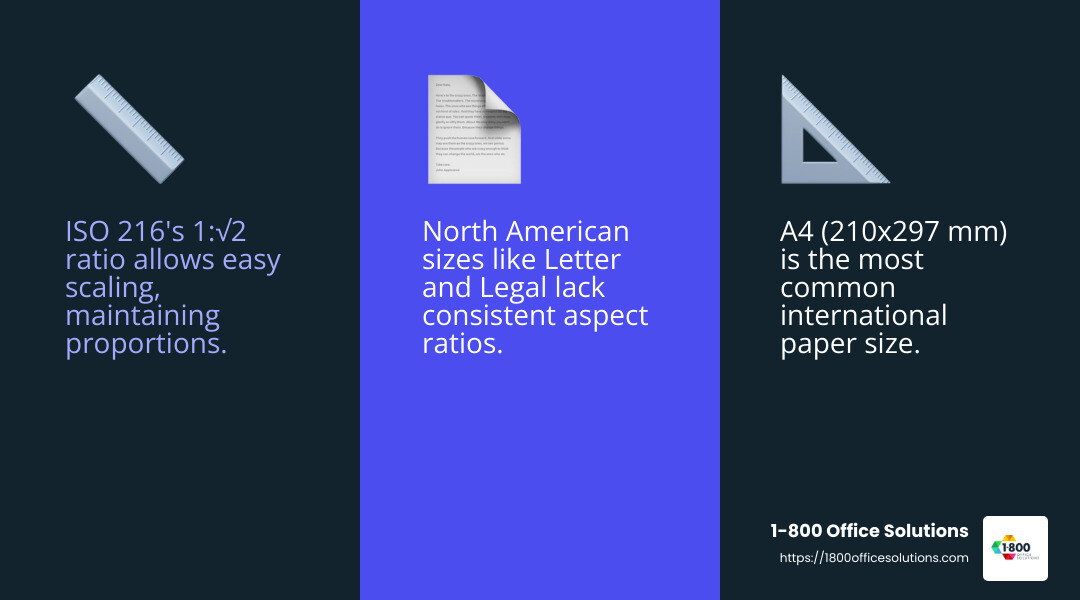
In summary, knowing the differences between these standards helps in choosing the right paper size for your needs. Whether you’re printing locally or internationally, understanding how these systems work can save you time and ensure your documents look professional.
Next, we’ll dive deeper into the specific printer paper size options available and how they compare across these standards.
Common Printer Paper Size Options
When it comes to printer paper size options, four sizes stand out: A4, Letter, Legal, and Tabloid. Each serves unique purposes and is popular in different regions.
A4
A4 paper measures 210 x 297 mm (about 8.3 x 11.7 inches). It’s the go-to size in countries using the ISO 216 standard. Think of A4 as the workhorse for offices outside North America. It’s used for everything from printing letters to reports.
The A-series paper sizes, including A4, have a unique advantage. Their 1:√2 aspect ratio allows for easy scaling. So, if you cut an A4 sheet in half, you get two A5 sheets, maintaining the same proportions. This makes resizing documents straightforward.
Letter
In North America, Letter size is king. Measuring 8.5 x 11 inches, it’s the default for most printers and copiers. This size is deeply rooted in American printing history, dating back to the early 20th century. Its widespread use makes it a staple for everyday documents like reports, letters, and resumes.
Legal
Legal paper is a bit longer, measuring 8.5 x 14 inches. It’s essential in legal settings, hence the name. The extra length is perfect for contracts and other documents that need more space for detailed information.
While Legal paper is less common than Letter, it plays a crucial role in law offices and other professional environments that handle lengthy documents.
Tabloid
Tabloid, also known as Ledger, measures 11 x 17 inches. Its larger size is ideal for graphics and design layouts, making it popular in the publishing and advertising industries. Think of Tabloid as your go-to for posters, presentations, and small print newspapers.
Printing on Tabloid often requires a multifunction printer (MFP) with an additional tray setup. But the larger canvas is worth it for visual-heavy projects.
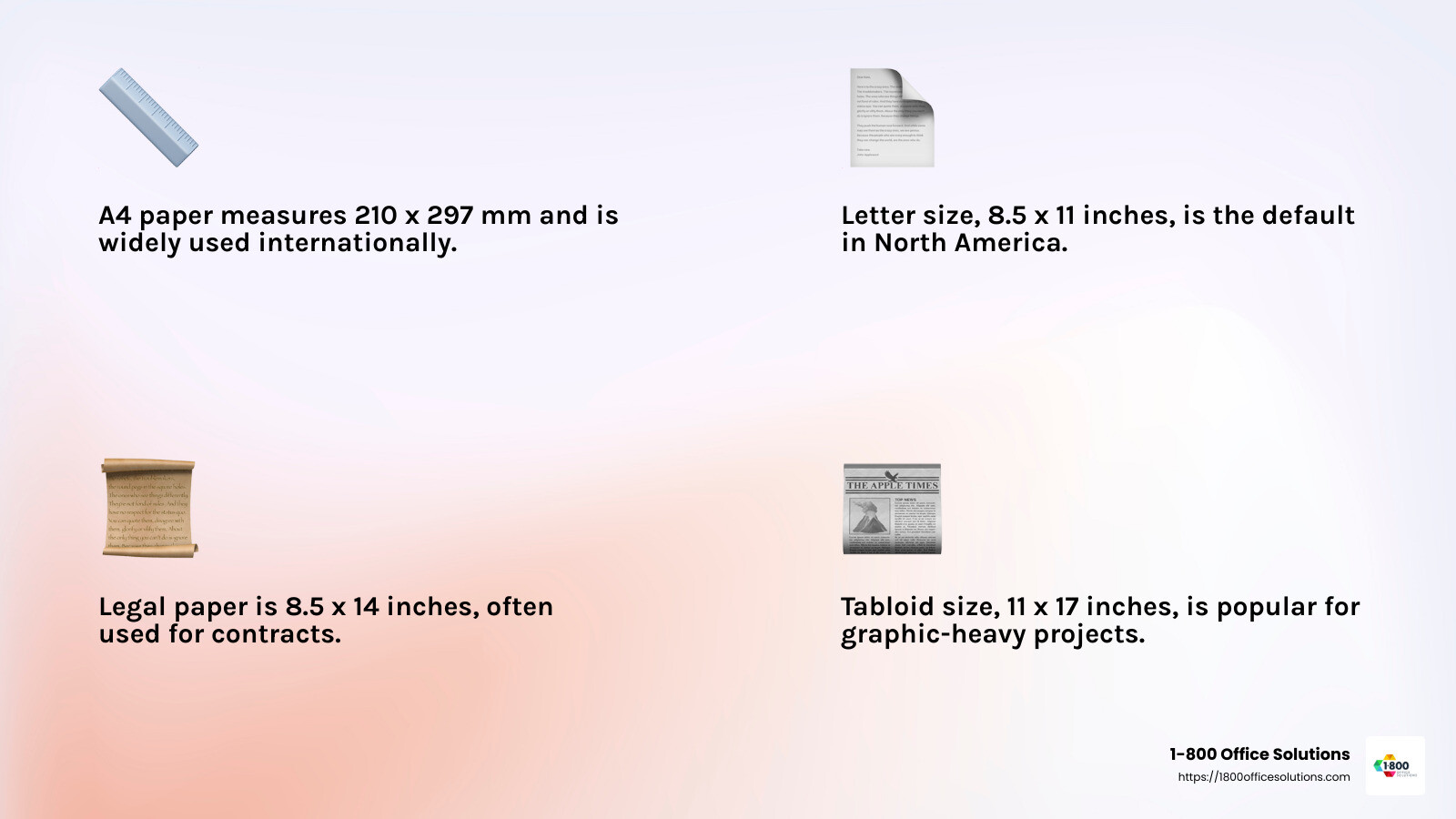
Conclusion
Understanding these printer paper size options is crucial for anyone involved in printing. Whether you’re using A4 in Europe or Letter in the U.S., knowing how these sizes compare can make all the difference in your printing tasks. Up next, we’ll explore how these sizes stack up against each other in international and North American contexts.
Comparing International and North American Paper Sizes
When navigating printing, understanding the differences between international and North American paper sizes is key. Let’s break down some common comparisons: A4 vs Letter, Legal vs A4, and Tabloid vs A3.
A4 vs Letter
A4 and Letter sizes are the most frequently used paper dimensions globally, but they serve different regions.
- A4: Measures 210 x 297 mm (about 8.3 x 11.7 inches). It’s the standard in countries that follow the ISO 216 standard, widely used across Europe and many other parts of the world. A4’s 1:√2 aspect ratio is perfect for scaling, maintaining proportions when resizing documents.
- Letter: Measures 8.5 x 11 inches and is the go-to size in North America. This size is deeply embedded in American history, dating back to traditional paper molds from the 20th century. It’s ideal for everyday documents like letters, reports, and resumes.
The main difference lies in the dimensions, with A4 being slightly taller and narrower than Letter. This can lead to formatting issues when printing documents across regions, especially if not adjusted properly.
Legal vs A4
Legal and A4 sizes cater to different needs, with Legal being less common but crucial in specific contexts.
- Legal: Measures 8.5 x 14 inches. It’s primarily used in legal settings for contracts and documents requiring extra length for detailed information. The additional space is a significant advantage for legal professionals.
- A4: As mentioned, is more versatile and used for a wide range of documents internationally.
When comparing Legal to A4, the extra length of Legal paper is the standout feature, offering more room for text-heavy documents. However, A4 remains more popular outside North America due to its adaptability and ease of use in various applications.
Tabloid vs A3
Tabloid and A3 sizes cater to larger format printing needs, often used in creative and design industries.
- Tabloid: Measures 11 x 17 inches. Known as Ledger when used in landscape, it’s favored for graphics-heavy documents like posters, presentations, and design layouts. Its larger canvas is perfect for visual projects.
- A3: Measures 297 x 420 mm (about 11.7 x 16.5 inches). Like A4, it follows the 1:√2 aspect ratio, making it easy to scale designs up or down without losing proportion.
Both sizes are similar, with A3 being slightly narrower and taller than Tabloid. This makes A3 a bit more versatile for scaling purposes, while Tabloid’s dimensions are better suited for North American design standards.
Understanding these differences and choosing the right size is crucial for seamless printing, especially for businesses operating internationally. Up next, we’ll dig into how to choose the right printer paper size based on your specific document types and printing needs.
How to Choose the Right Printer Paper Size
Choosing the right printer paper size is crucial for achieving the best results in your printing projects. Here’s how to make the right choice based on document type, printing needs, and paper quality:
Document Type
The type of document you’re printing often dictates the paper size you’ll need:
- Letters and Reports: For everyday documents like business letters and reports, the Letter size (8.5 x 11 inches) is standard in North America. For international use, A4 (210 x 297 mm) is the norm.
- Legal Documents: If you’re dealing with contracts or legal documents, the Legal size (8.5 x 14 inches) offers extra length, providing more space for detailed information.
- Posters and Brochures: Creative projects like posters and brochures benefit from larger sizes. Tabloid (11 x 17 inches) and A3 (297 x 420 mm) are perfect for graphics-heavy designs, offering ample space for visuals.
Printing Needs
Consider what you’re printing and how it will be used:
- Professional Presentations: For presentations that need to impress, opt for higher quality paper in Tabloid or A3 sizes. These offer a larger canvas for charts and visuals.
- Double-Sided Printing: If you’re printing on both sides, consider the paper’s opacity. Higher opacity means less show-through, which is ideal for documents like manuals or reports.
- Bulk Printing: For large volumes, such as flyers or newsletters, standard sizes like Letter or A4 are cost-effective and widely accepted.
Paper Quality
The quality of the paper affects the final look of your printed documents:
- Weight and Thickness: Heavier paper, like cardstock, is more durable and gives a premium feel. For instance, a 28-pound paper is thicker and sturdier than a 20-pound one, making it ideal for important documents.
- Brightness and Opacity: High brightness levels make colors pop, while higher opacity prevents text from showing through. Choose a brightness level in the 80s or low 90s for text documents, and higher for color graphics.
By considering these factors, you can select the perfect printer paper size options for your needs, ensuring your documents look professional and are fit for purpose. Next, we’ll tackle some common questions about paper sizes to clear up any lingering confusion.
Frequently Asked Questions about Printer Paper Size Options
Is 8.5 x 11 the same as A5?
No, 8.5 x 11 inches, known as Letter size, is not the same as A5. The Letter size is a standard paper size in North America, commonly used for everyday documents like reports and letters.
In contrast, A5 size measures 148 x 210 mm (5.83 x 8.27 inches). It’s half the size of A4 and is often used for booklets, flyers, and personal notebooks. It’s compact and perfect for smaller print jobs.
What’s bigger, A6 or A7 paper?
When comparing A6 and A7 sizes, A6 is the larger of the two. Here’s a quick look at their dimensions:
- A6 size: 105 x 148 mm (4.13 x 5.83 inches)
- A7 size: 74 x 105 mm (2.91 x 4.13 inches)
A6 is commonly used for postcards and small brochures, while A7 is ideal for small cards and tickets due to its compact size.
Is standard printer paper A4 or A5?
The term “standard printer paper” often refers to A4 size, especially in international contexts. A4 measures 210 x 297 mm (8.27 x 11.69 inches) and is the most widely used paper size for office documents, letters, and reports globally.
A5, on the other hand, is smaller and typically used for specific applications like booklets and flyers. In North America, the equivalent of “standard printer paper” would be the Letter size (8.5 x 11 inches), which serves a similar purpose to A4 in other parts of the world.
Understanding these printer paper size options helps ensure you choose the right size for your printing needs, whether you’re working on a small project or a large-scale print job.
Conclusion
At 1-800 Office Solutions, we understand the importance of selecting the right paper size for your printing tasks. Whether you’re working on everyday office documents or specialized projects, choosing the correct printer paper size options can significantly impact the quality and efficiency of your work.
When selecting paper, consider the type of document you’re printing. For instance, Letter size (8.5 x 11 inches) is perfect for standard reports and letters, while Legal size (8.5 x 14 inches) is ideal for contracts and legal documents. If you’re handling larger projects, such as posters or newsletters, Tabloid size (11 x 17 inches) might be your best choice.
Don’t forget about paper quality. High-quality paper not only improves the appearance of your documents but also reduces the risk of jams and printer wear. As we’ve seen, cheap paper can lead to extra lint and frequent jams, affecting both the output and the printer’s longevity.
Our team at 1-800 Office Solutions is here to guide you through your printing needs. With locations across Orlando, Chicago, Arkansas, Pennsylvania, North Carolina, Massachusetts, Michigan, and Georgia, we are well-positioned to support your business operations.
For more comprehensive advice on selecting the right printer and paper for your needs, visit our Ultimate Printer Guide. Here, you’ll find detailed information to help you make informed decisions, ensuring that your printing processes are both effective and efficient.






